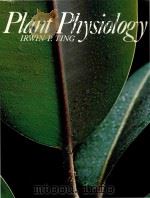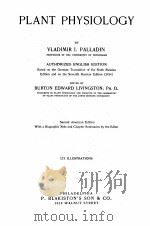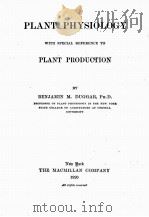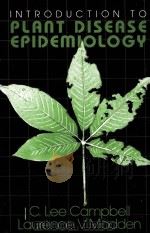《introduction to plant physiology P560》求取 ⇩
| 作者 | 编者 |
|---|---|
| 出版 | 未查询到或未知 |
| 参考页数 | ✅ 真实服务 非骗流量 ❤️ |
| 出版时间 | 没有确切时间的资料 目录预览 |
| ISBN号 | 无 — 违规投诉 / 求助条款 |
| PDF编号 | 820577488(学习资料 勿作它用) |
| 求助格式 | 扫描PDF(若分多册发行,每次仅能受理1册) |

Chapter 1 · Cells, Tissues, and Organs:The Architecture of Plants1
1.1The Plant Cell2
1.2Building Blocks: Lipids, Proteins,and Carbohydrates2
1.2.1 Lipids Are a Class of Molecules That Includes Fats,Oils, Sterols, and Pigments4
1.2.2 Proteins Play a Central Role in the Biochemistry of Cells and Are Responsible for Virtually All the Properties of Life as We Know it6
1.2.3 Carbohydrates Are the Most Abundant Class of Biological Molecules8
1.3Biological Membranes11
1.3.1 The Membrane Lipid Forms a Bilayer, a Highly Fluid but Very Stable Structure11
1.3.2 Membranes Contain Significant Amounts of Protein12
1.4Cellular Organelles13
1.4.1 Most Mature Plant Cells Contain a Large, Central Vacuole13
1.4.2 The Nucleus Is the Information Center of the Cell13
1.4.3 The Endoplasmic Reticulum and Golgi Apparatus Are Centers of Membrane Biosynthesis and Secretory Activities14
1.4.4 The Mitochondrion Is the Principal Site of Cellular Respiration15
1.4.5 Plastids Are a Family of Organelles with a Variety of Functions15
1.4.6 Microbodies Are Metabolically Very Active16
1.5 Cytoskeleton16
1.6The Extracellular Matrix17
1.6.1 The Primary Cell Wall Is a Flexible Network of Cellulose Microfibrils and Cross-Linking Glycans17
1.6.2 The Cellulose-Glycan Lattice is Embedded in a Matrix of Pectin and Protein19
1.6.3 Cellulose Microfibrils Are Assembled at the Plasma Membrane as They Are Extruded into the Cell Wall20
1.6.4 The Secondary Cell Wall Is Deposited on the Inside of the Primary Wall in Maturing Cells21
1.6.5 Plasmadesmata Are Cytoplasmic Channels Extend Through the Wall to Connect the Protoplasts of Adjacent Cells21
1.7Tissues and Organs22
1.7.1 Tissues Are Groups of Cells That Form an Organized, Functional Unit22
1.7.2 Meristems Are Regions of Perpetually Dividing Cells22
1.7.3 Parenchyma Is the Most Abundant Living Tissue in Plants24
1.7.4 Supporting Tissues Are Distributed Throughout the Primary and Secondary Plant Bodies24
1.7.5 Vascular Tissues Are the Principal Conducting Tissues for Water and Nutrients25
1.7.6 Epidermis Is a Superficial Tissue That Forms a Continuous Layer over the Surface of the Primary Plant Body25
1.8Plant Organs26
1.8.1 Roots Anchor the Plant and Absorb Water and Minerals from the Soil26
1.8.2 Stems Elevate the Photosynthetic Organs, the Leaves, Toward the Sun26
1.8.3 Leaves Are the Principal Photosynethic Organs27
Summary27
Chapter Review28
Further Reading28
Part 1 ·Plants and Energy29
Chapter 2 · Bioenergetics and ATP Synthesis31
2.1Bioenergetics and Energy Transformations in Living Organisms31
2.1.1 The Sun Is a Primary Source of Energy31
2.1.2 What Is Bioenergetics?32
2.1.3 The First Law of Thermodynamics Refers to Energy Conservation32
2.1.4 The Second Law of Thermodynamics Refers to Entropy and Disorder33
2.1.5 The Ability to Do Work is Dependent on the Availability of Free Energy33
2.1.6 Free Energy Is Related to Chemical Equilibria34
2.2Energy Transformations and Coupled Reactions35
2.2.1 Free Energy of ATP Is Associated with Coupled Phosphate Transfer Reactions35
2.2.2 Free Energy Changes Are Associated with Coupled Oxidation-Reduction Reactions36
2.3Energy Transduction and the Chemiosmotic Synthesis of ATP39
2.3.1 Chloroplasts and Mitochondria Exhibit Specific Compartments39
2.3.2 Chloroplasts and Mitochondria Synthesize ATP by Chemiosmosis41
Summary43
Chapter Review43
Further Reading43
Chapter 3 · The Dual Role of Sunlight:Energy and Information45
3.1The Physical Nature of Light45
3.1.1 Light Is Electromagnetic Energy Which Exists in Two Forms45
3.1.2 Light Can Be Characterized as a Wave Phenomenon46
3.1.3 Light Can Be Characterized as a Stream of Discrete Particles46
3.1.4 Light Energy Can Interact with Matter47
3.1.5 How Does One Illustrate the Efficiency of Light Absorption and Its Physiological Effects49
3.1.6 Accurate Measurement of Light Is Important in Photobiology50
3.2 The Natural Radiation Environment51
3.3Photoreceptors Absorb Light for Use in a Physiological Process52
3.1.1 Chlorophylls Are Primarily Responsible for Harvesting Light Energy for Photosynthesis52
3.3.2 Phycobilins Serve as Accessory Light-Harvesting Pigments in the Red Algae and Cyanobacteria or as a Critical Regulatory System in Green Plants54
3.3.3 Carotenoids Account for the Autumn Colors55
3.3.4 Cryptochrome Is a Photoreceptor Sensitive to Blue and UV-A Light57
3.3.5 UV-B Radiation May Act as a Developmental Signal57
3.3.6 Flavonoids Provide the Myriad of Flower Colors and Act as a Natural Sunscreen58
3.3.7 Betacyanins and Beets60
Summary60
Chapter Review61
Further Reading61
Chapter 4 · Energy Conservation in Photosynthesis: Harvesting Sunlight63
4.1Leaves Are Photosynthetic Machines Which Maximize the Absorption of Light64
4.2 Photosynthesis Is an Oxidation-Reduction Process66
4.3Photosynthetic Electron Transport68
4.3.1 Photosystems Are Major Components of the Photosynthetic Electron Transport Chain68
4.3.2 Photosystem Ⅱ Oxidizes Water to Produce Oxygen71
4.3.3 The Cytochrome Complex and Photosystem ⅠOxidize Plastoquinol72
4.4 Photophosphorylation Is the Light-Dependent Synthesis of ATP73
4.5 Lateral Heterogeneity Is the Unequal Distribution of Thylakoid Complexes75
4.6 Light-Harvesting Complexes Are Superantenna Complexes that Regulate Energy Distribution76
4.7Photoinhibition of Photosynthesis: Photoprotection versus Photodamage78
4.7.1 Carotenoids Serve a Dual Function: Light Harvesting and Photoprotection78
4.7.2 Oxygen May Protect against Photoinhibition by Acting as an Alternative Electron Acceptor80
4.7.3 The D1 Repair Cycle Overcomes Photodamage to PSII82
4.8 Inhibitors of Photosynthetic Electron Transport Are Effective Herbicides83
Summary86
Chapter Review86
Fur ther Reading87
Box 4.1 · Historical Perspective—The Discovery of Photosynthesis66
Box 4.2 · The Case for Two Photosystems84
Chapter 5 · Energy Conservation in Photosynthesis: CO2 Assimilation89
5.1Stomatal Complex Controls Leaf Gas Exchange and Water Loss90
5.2 CO2 Enters the Leaf by Diffusion92
5.3 How Do Stomata Open and Close?94
5.4Stomatal Movements Are Also Controlled By External Environmental Factors96
5.4.1 Light and Carbon Dioxide Regulate Stomatal Opening96
5.4.2 Water Status and Temperature Influence Stomatal Opening98
5.4.3 Stomatal Movements Follow Endogenous Rhythms98
5.5The Photosynthetic Carbon Reduction (PCR) Cycle98
5.5.1 The PCR Cycle Reduces CO2 to Produce a 3-Carbon Sugar98
5.5.2 The Carboxylation Reaction Fixes the CO299
5.5.3 ATP and NADPH Are Consumed in the PCR Cycle102
5.5.4 What Are the Energetics of the PCR Cycle?102
5.6The PCR Cycle Is Highly Regulated102
5.6.1 The Regeneration of RuBP Is Autocatalytic102
5.6.2 Rubisco Activity Is Regulated Indirectly by Light103
5.6.3 Other PCR Enzymes Are also Regulated by Light104
5.7Chloroplasts of C3 Plants also Exhibit Competing Carbon Oxidation Processes104
5.7.1 Rubisco Catalyzes the Fixation of Both CO2 and O2105
5.7.2 Why Photorespiration?106
5.7.3 In Addition to PCR, Chloroplasts Exhibit an Oxidative Pentose Phosphate Cycle (OPPC)108
5.8 The C4 Syndrome: Another Biochemical Mechanism to Assimilate CO2108
5.9 The C4 Syndrome Is Usually Associated with Kranz Leaf Anatomy112
5.10The C4 Syndrome Has Ecological Significance112
5.10 .1 The C4 Syndrome Is Differentially Sensitive to Temperature113
5.10 .2 The C4 Syndrome Is Associated with Water Stress113
5.11Crassulacean Acid Metabolism (CAM): An Adaptation to Life in the Desert115
5.11 .1 Is CAM a Variation of the C4 Syndrome?115
5.11 .2 CAM Plants Are Particularly Suited to Dry Habitats115
5.12 C4 and CAM Photosynthesis Require Precise Regulation and Temporal Integration117
Summary121
Chapter Review122
Further Reading122
Box 5.1 · Enzymes118
Chapter 6 · Allocation, Translocation, and Partitioning of Photoassimilates123
6.1Starch and Sucrose Are Biosynthesized in Two Different Compartments124
6.1.1 Starch Is Biosynthesized in the Stroma124
6.1.2 Sucrose Is Biosynthesized in the Cytosol125
6.2 Starch and Sucrose Biosynthesis Are Competitive Processes126
6.3Photoassimilates Are Translocated over Long Distances128
6.3.1 What Is the Composition of the Photoassimilate Translocated by the Phloem?129
6.4Sieve Elements Are the Principal Cellular Constituents of the Phloem131
6.4.1 Phloem Exudate Contains a Significant Amount of Protein132
6.5 Direction of Translocation Is Determined by Source-Sink Relationships133
6.6 Phloem Translocation Occurs by Mass Transfer133
6.7Phloem Loading and Unloading Regulate Translocation and Partitioning136
6.7.1 Phloem Loading Can Occur Symplastically or Apoplastically136
6.7.2 Phloem Unloading May Occur Symplastically or Apoplastically138
6.8Photoassimilate Is Distributed Between Different Metabolic Pathways and Plant Organs139
6.8.1 Photoassimilates May Be Allocated to a Variety of Metabolic Functions in the Source or the Sink140
6.8.2 Distribution of Photoassimilates Between Competing Sinks Is Determined By Sink Strength141
6.9 Xenobiotic Agrochemicals Are Translocated in the Phloem143
Summary144
Chapter Review144
Further Reading144
Chapter 7 · Cellular Respiration: Unlocking the Energy Stored in Photoassimilates145
7.1Cellular Respiration Consists of a Series of Pathways by Which Photoassimilates Are Oxidized146
7.2Sucrose and Starch Are Broken Down into Glucose147
7.2.1 α-Amylase Produces Maltose and Limit Dextrins148
7.2.2 β-Amylase Produces Maltose148
7.2.3 Limit Dextrinase Is a Debranching Enzyme148
7.2.4 α-Glucosidase Hydrolyzes Maltose148
7.2.5 Starch Phosphorylase Catalyzes the Phosphorolytic Degradation of Starch149
7.3Glycolysis Converts Sugars to Pyruvic Acid150
7.3.1 Hexoses Must Be Phosphorylated to Enter Glycolysis150
7.3.2 Triose Phosphates Are Oxidized to Pyruvate151
7.4 The Oxidative Pentose Phosphate Pathway Is an Alternative Route for Glucose Metabolism151
7.5 The Fate of Pyruvate Depends on the Availability of Molecular Oxygen152
7.6Oxidative Respiration Is Carried Out by the Mitochondrion153
7.6.1 In the Presence of Molecular Oxygen, Pyruvate Is Completely Oxidized to CO2 and Water by the Citric Acid Cycle153
7.6.2 Electrons Removed from Substrate in the Citric Acid Cycle Are Passed to Molecular Oxygen Through the Mitochondrial Electron Transport Chain154
7.7 Energy Is Conserved in the Form of ATP in Accordance with Chemiosmosis156
7.8Plants Contain Several Alternative Electron Pathways157
7.8.1 Plant Mitochrondria Contain External Dehydrogenases157
7.8.2 Plants Have a Rotenone-Insensitive NADH Dehydrogenase158
7.8.3 Plants Exhibit Cyanide-Resistant Respiration158
7.9 Many Seeds Store Carbon as Oils Which Are Converted to Sugar159
7.10 Respiration Provides Carbon Skeletons for Biosynthesis161
7.11 Respiration Rate Varies with Development and Metabolic State162
7.12Respiration Rate Responds to Environmental Conditions163
7.12 .1 Light163
7.12 .2 Temperature164
7.12 .3 Oxygen Availability164
Summary165
Chapter Review165
Further Reading165
Chapter 8 · Nitrogen Assimilation167
8.1The Nitrogen Cycle: A Complex Pattern of Exchange167
8.1.1 Ammonification, Nitrification, and Denitrification Are Essential Processes in the Nitrogen Cycle168
8.1.2 Nitrogen Fixation Reduces N2 to Ammonia168
8.2Biological Nitrogen Fixation Is Exclusively Prokaryotic169
8.2.1 Some Nitrogen-Fixing Bacteria Are Free-Living Organisms169
8.2.2 Symbiotic Nitrogen Fixation Involves Specific Associations Between Bacteria and Plants169
8.3Legumes Exhibit Symbiotic Nitrogen Fixation170
8.3.1 Rhizobia Infect the Host Roots Which Induces Nodule Development170
8.4The Biochemistry of Nitrogen Fixation174
8.4.1 Nitrogen Fixation Is Catalyzed by the Enzyme Dinitrogenase174
8.4.2 Nitrogen Fixation Is Energetically Costly175
8.4.3 Dinitrogenase Is Sensitive to Oxygen175
8.4.4 Dinitrogenase Results in the Production of Hydrogen Gas176
8.5The Genetics of Nitrogen Fixation177
8.5.1 nif Genes Code for Nitrogenase177
8.5.2 nod Genes and nif Genes Regulate Nodulation177
8.5.3 What Is the Source of Heme for Leghemoglobin?177
8.6NH3 Produced by Nitrogen Fixation is Converted to Organic Nitrogen178
8.6.1 Ammonium Is Assimilated by GS/GOGAT178
8.6.2 Fixed Nitrogen Is Exported As Asparagine and Ureides179
8.7 Plants Generally Take up Nitrogen in the Form of Nitrate181
8.8 Nitrogen Cycling: Simultaneous Importand Export182
8.9 Agricultural and Ecosystem Productivity Is Dependent on Nitrogen Supply183
Summary184
Chapter Review185
Further Reading185
Box 8.1 · Lectins—Proteins with a Sweet Tooth172
Chapter 9 · Carbon Assimilation and Productivity187
9.1Productivity Refers to an Increase in Biomass187
9.2 Carbon Economy Is Dependent on the Balance Between Photosynthesis and Respiration188
9.3Productivity Is Influenced by a Variety of Genetic and Environmental Factors189
9.3.1 Fluence Rate189
9.3.2 Available CO2190
9.3.3 Temperature192
9.3.4 Soil Water Potential193
9.3.5 Nutrient Supply, Pathology, and Pollutants193
9.3.6 Leaf Factors194
9.4 Primary Productivity on a Global Scale196
Summary197
Chapter Review197
Further Reading198
Part 2 · Plants, Water, and Minerals200
Chapter 10 · Plant Cells and Water201
10.1Water Has Unique Physical and Chemical Properties202
10.2The Thermal Properties of Water Are Biologically Important203
10.2.1 Water Exhibits a Unique Thermal Capacity203
10.2.2 Water Exhibits a High Heat of Fusion and Heat of Vaporization203
10.3 Water Is the Universal Solvent204
10.4 Polarity of Water Molecules Results in Cohesion and Adhesion205
10.5Water Movement May Be Governed by Diffusion or by Bulk Flow205
10.5.1 Bulk Flow Is Driven by Hydrostatic Pressure205
10.5.2 Fick's First Law Describes the Process of Diffusion206
10.6Osmosis Is the Diffusion of Water Across a Selectively Permeable Membrane207
10.6.1 Osmosis in Plant Cells Is Indirectly Energy Dependent207
10.6.2 The Chemical Potential of Water Has an Osmotic as Well as Pressure Component209
10.7 Hydrostatic Pressure and Osmotic Pressure Are Two Components of Water Potential210
10.8 Water Potential Is the Sum of Its Component Potentials211
10.9 Dynamic Flux of H2O Is Associated with Changes in Water Potential212
10.10 How Elastic Are Cell Walls?213
Summary217
Chapter Review217
Further Reading217
Box 10.1 · Osmosensors214
Chapter 11 · Whole Plant Water Relations219
11.1Transpiration Is Driven by Differences in Vapor Pressure220
11.2 Transpiration Can Be Measured by Weight Loss and Gas Exchange221
11.3 The Driving Force of Transpiration Is Differences in Vapor Pressure221
11.4The Rate of Transpiration Is Influenced by Environmental Factors222
11.4.1 What Are the Effects of Humidity?223
11.4.2 What Is the Effect of Temperature?224
11.4.3 What Is the Effect of Wind?224
11.5 Water Conduction Occurs via Tracheary Elements225
11.6The Ascent of Xylem Sap Is Explained by Combining Transpiration with Cohesive Forces of Water228
11.6.1 Root Pressure Is Related to Root Structure229
11.6.2 Water Rise by Capillarity Is Due to Adhesion and Surface Tension231
11.6.3 The Cohesion Theory Best Explains the Ascent of Xylem Sap231
11.7Water Loss Due to Transpiration Must Be Replenished235
11.7.1 Soil Is a Complex Medium235
11.8 Roots Absorb and Transport Water237
11.9 The Permeability of Roots to Water Varies237
11.10 Radial Movement of Water Through the Root Involves Two Possible Pathways238
Summary240
Chapter Review240
Further Reading240
Box 11.1 · Why Transpiration?226
Box 11.2 · Forces Involved in Capillary Rise232
Chapter 12 · Plants and Inorganic Nutrients241
12.1Methods and Nutrient Solutions242
12.1.1 Interest in Plant Nutrition Is Rooted in the Study of Agriculture and Crop Productivity242
12.1.2 The Use of Hydroponic Culture Helped to Define the Mineral Requirements of Plants242
12.1.3 Modern Techniques Overcome Inherent Disadvantages of Simple Solution Culture243
12.2The Essential Nutrient Elements245
12.2.1 Seventeen Elements Are Deemed to Be Essential for Plant Growth and Development245
12.2.2 The Essential Nutrients Are Generally Classed as either Macronutrients or Micron Nutrients245
12.2.3 Determining Essentiality of Micronutrients Presents Special Problems245
12.3Beneficial Elements246
12.3.1 Sodium Is an Essential Micronutrient for C4 Plants247
12.3.2 Silicon May Be Beneficial for a Variety of Species247
12.3.3 Cobalt Is Required by Nitrogen-Fixing Bacteria247
12.3.4 Some Plants Tolerate High Concentrations of Selenium247
12.4Nutrient Functions and Deficiency Symptoms247
12.4.1 A Plant's Requirement for a Particular Element Is Defined in Terms of Critical Concentration248
12.4.2 Nitrogen Is a Constituent of Many Critical Macromolecules249
12.4.3 Phosphorous Is Part of the Nucleic Acid Backbone and Has a Central Function in Intermediary Metabolism249
12.4.4 Potassium Activates Enzymes and Functions in Osmoregulation250
12.4.5 Sulfur Is an Important Constituent of Proteins,Coenzymes, and Vitamins250
12.4.6 Calcium Is Important in Cell Division, Cell Adhesion, and as a Secondary Messenger251
12.4.7 Magnesium Is a Constituent of the Chlorophyll Molecule and Is an Important Regulator of Enzyme Reaction251
12.4.8 Iron Is Required for Chlorophyll Synthesis and Electron Transfer Reactions251
12.4.9 Boron Appears to Have a Role in Cell Division and Elongation and Contributes to the Structural Integrity of the Cell Wall253
12.4.10 Copper Is a Necessary Cofactor for Oxidative Enzymes254
12.4.11 Zinc Is an Activator of Numerous Enzymes254
12.4.12 Manganese Is an Enzyme Cofactor as Well as Part of the Oxygen-Evolving Complex in the Chloroplast254
12.4.13 Molybdenum Is a Key Component of Nitrogen Metabolism254
12.4.14 Chlorine Has a Role in Photosynthetic Oxygen Evolution and Balances Charge Across Cellular Membranes255
12.4.15 The Role of Nickel Is Not Clear255
12.5 Toxicity of Micronutrients256
Summary256
Chapter Review256
Further Reading257
Chapter 13 · Roots, Soils, and Nutrient Uptake259
13.1The Soil as a Nutrient Reservoir260
13.1.1 Colloids Are a Significant Component of Most Soils260
13.1.2 Colloids Present a Large, Negatively Charged Surface Area260
13.1.3 Soil Colloids Reversibly Adsorb Cations from the Soil Solution261
13.1.4 The Anion Exchange Capacity of Soil Colloids Is Relatively Low 26113.2 Nutrient Uptake262
13.2.1 Nutrient Uptake by Plants Requires Transport of the Nutrient across Root Cell Membranes262
13.2.2 Simple Diffusion Is a Purely Physical Process262
13.2.3 The Movement of Most Solutes across Membranes Requires the Participation of Specific Transport Proteins263
13.2.4 Active Transport Requires the Expenditure of Metabolic Energy263
13.3 Selective Accumulation of Ions by Roots266
13.4Electrochemical Gradients and Ion Movement266
13.4.1 Ions Move in Response to Electrochemical Gradients266
13.4.2 The Nernst Equation Helps to Predict Whether an Ion Is Exchanged Actively or Passively267
13.5Active Transport and Electrogenic Pumps269
13.5.1 Active Transport Is Driven by ATPase-Proton Pumps269
13.5.2 The ATPase-Proton Pumps of Plasma Membranes and Vacuolar Membranes Are Different270
13.5.3 K+ Exchange Is Mediated by Two Classes of Transport Proteins271
13.6Ion Uptake by Roots272
13.6.1 A First Step in Mineral Uptake by Roots Is Diffusion into the Apparent Free Space272
13.6.2 Apparent Free Space Is Equivalent to the Apoplast of the Root Epidermal and Cortical Cells273
13.7The Radial Path of Ion Movement Through Roots274
13.7.1 Ions Entering the Stele Must First Be Transported from the Apparent Free Space into the Symplast274
13.7.2 Ions Are Actively Secreted into the Xylem Apoplast274
13.7.3 Emerging Secondary Roots May Contribute to the Uptake of Some Solutes275
13.8Root-Microbe Interactions276
13.8.1 Bacteria Other Than Nitrogen Fixers Contribute to Nutrient Uptake by Roots276
13.8.2 Mycorrhizae Are Fungi that Increase the Volume of the Nutrient Depletion Zone Around Roots276
Summary279
Chapter Review279
Further Reading280
Box 13.1 · Electrophysiology—Exploring Ion Channels264
Part 3 · Plant Development281
Chapter 14 · Patterns in Plant Development283
14.1Growth, Differentiation, and Development283
14.1.1 Development Is the Sum of Growth and Differentiation283
14.1.2 Growth Is an Irreversible Increase in Size284
14.1.3 Differentiation Refers to Qualitative Changes That Normally Accompany Growth284
14.2Control of Development285
14.2.1 The Orderly Development of a Plant Requires a Programmed Sequence of Gene Expression285
14.2.2 Hormones Coordinate Cell-Cell Interactions287
14.2.3 A Continuous Stream of Environmental Signals Provide Information That Plants Use to Modify Their Development287
14.3Signal Perception and Transduction287
14.3.1 Signals Are Perceived by Protein Receptors288
14.3.2 Signal Transduction Includes a Diverse Array of Second Messengers and Biochemical Mechanisms288
14.3.3 There Is Extensive Cross-Talk among Signal Pathways291
14.4Cell Walls and Cell Growth291
14.4.1 Cell Growth Is Driven by Water Uptake and Limited by the Strength and Rigidity of the Cell Wall291
14.4.2 Extension of the Cell Wall Requires Wall-Loosening Events That Enable Load-Bearing Elements in the Wall to Yield to Turgor Pressure292
14.4.3 Wall Loosening and Cell Expansion Are Stimulated by Low pH and Expansins293
14.5A Survey of Plant Development294
14.5.1 Seed Structure and Development294
14.5.2 Seed Germination295
14.5.3 Shoot Development295
14.5.4 Root Development299
14.5.5 Flower Evocation and Development301
14.5.6 Flower and Fruit Development301
14.5.7 Senescence and Programmed Cell Death Are the Final Stages of Development302
14.6Kinetic Analysis of Growth303
14.6.1 Growth of Microorganisms in Culture Exhibit Exponential Growth303
14.6.2 Growth of Multicellular Organisms Is Determined by the Activity of the Meristem306
Summary306
Chapter Review306
Further Reading306
Box 14.1 · Development in a Mutant Weed286
Box 14.2 · Ubiquitin and Proteosomes—Cleaning Up Unwanted Proteins304
Chapter 15 · The Plant Hormones:Biochemistry and Metabolism309
15.1Do Plants Have Hormones?309
15.1.1 There Are Subtle Differences Between Animal and Plant Hormones310
15.1.2 The List of Plant Hormones Is Growing312
15.1.3 The Amount of Hormone in a Tissue Is Governed by Several Factors312
15.2Auxin313
15.2.1 The Principal Auxin in Plants Is Indole-3-Acetic Acid (IAA)314
15.2.2 IAA Is Synthesized from the Amino Acid L-Tryptophan316
15.2.3 Some Plants Do Not Require Tryptophan for IAA Biosynthesis316
15.2.4 IAA May Be Stored As Inactive Conjugates318
15.2.5 There Are Two Principal Mechanisms for Deactivation of IAA318
15.3Gibberellins320
15.3.1 There Are Three Principal Sites for Gibberellin Biosynthesis320
15.3.2 Gibberellins Are Terpenes, Sharing a Core Pathway with Several Other Hormones and a Wide Range of Secondary Products322
15.3.3 Gibberellins Are Synthesized from Geranylgeranyl Pyrophosphate (GGPP)323
15.3.4 Growth Retardants Block the Synthesis of Gibberellins324
15.3.5 Gibberellins Are Deactivated by 2β-Hydroxylation324
15.3.6 Gibberellin Transport Is Poorly Understood325
15.4Cytokinins325
15.4.1 Cytokinins Are Synthesized Primarily in the Root325
15.4.2 Cytokinin Biosynthesis Begins with the Condensation of an Isopentenyl Group with the Amino Group of Adenosine Monophosphate326
15.4.3 Cytokinins May Be Reversibly or Irreversibly Deactivated by Conjugation and Irreversibly Deactivated by Oxidation329
15.5. Abscisic Acid329
15.5.1 Abscisic Acid Is Synthesized Primarily in Mature Leaves330
15.5.2 Abscisic Acid Is Synthesized from the Cleavage Product of a 40-Carbon Carotenoid Precursor330
15.5.3 Abscisic Acid Is Degraded by Oxidation to PhaseicAcid332
15.6Ethylene332
15.6.1 Ethylene Is Synthesized from the Amino Acid Methionine332
15.6.2 Ethylene and Polyamine Biosynthesis Share a Common Precursor334
15.6.3 Excess Ethylene Is Subject to Oxidation334
15.7Brassinosteroids334
15.7.1 Brassinosteroids Are Polyhydroxylated Sterols Derived from the Triterpene Squalene335
15.7.2 Several Routes for Deactivation of Brassinosteroids Have Been Identified335
15.8Polyamines335
15.8.1 The Pathway for Polyamine Biosynthesis Is the Same in Plants, Microorganisms, and Mammals337
Summm y338
Chapter Review338
FurtherReading339
Box 15.1 · Historical Perspectives—Discovering Plant Hormones311
Chapter 16 · The Plant Hormones: Control of Development341
16.1Cell Division, Enlargement, and Differentiation341
16.1.1 Cytokinins Are a Significant Factor in Regulating Cell Division341
16.1.2 Cytokinins Regulate Progression Through the Cell Cycle342
16.1.3 Auxins Stimulate Cell Enlargement in Excised Tissues344
16.1.4 The Acid-Growth Hypothesis Explains Auxin Control of Cell Enlargement344
16.1.5 Maintenance of Auxin-Induced Growth Requires Gene Activation347
16.1.6 Many Aspects of Plant Development Are Linked to the Polar Transport of Auxin349
16.1.7 Auxins and Cytokinins Regulate Vascular Differentiation351
16.2Seed Development and Germination352
16.2.1 The Level and Activities of Various Hormones Change Dramatically During Seed Development352
16.2.2 Gibberellins Stimulate Mobilization of Nutrient Reserves During Germination of Cereal Grains353
16.3Shoot and Root Development356
16.3.1 Gibberellins Stimulate Hyperelongation of Intact Stems, Especially in Dwarf and Rosette Plants356
16.3.2 Inhibition of Gibberellin Biosynthesis Has Commercial Applications357
16.3.3 Hormone Mutants Indicate a Role for Brassinosteroids and Ethylene in Stem Growth358
16.3.4 The Ratio of Auxin to Cytokinin Controls the Growth of Axillary Buds358
16.3.5 Root Elongation and Development Is Particularly Sensitive to Auxin and Ethylene359
16.4Senescence and Abscission360
16.4.1 Cytokinins and Ethylene Are Antagonistic in the Regulation of Nutrient Mobilization and Senescence360
16.4.2 Auxin Regulates Leaf Abscission362
16.5Flower and Fruit Development362
16.5.1 Gibberellins Promote Precocious Flowering in Some Species363
16.5.2 Auxin and Gibberellin Influence the Sex of Flowers363
16.5.3 Hormones Influence Fruit Set and Development364
16.6Ethylene364
16.6.1 The Study of Ethylene Presents a Unique Set of Problems364
16.6.2 Ethylene Affects Many Aspects of Vegetative Development364
Summary365
Chapter Review366
Further Reading366
Box 16.1 · The Cell Cycle and Control of Cell Division343
Box 16.2 · Commercial Applications of Hormones348
Chapter 17 · Photomorphogenesis:Responding to Light367
17.1Photomorphogenesis368
17.2Phytochrome: Responses to Red and Far-Red Light368
17.2.1 Photoreversibility Is the Hallmark of Phytochrome Action370
17.2.2 Phytochromes Are Phycobilin Pigments371
17.2.3 Conversion of Pr to Pfr in Etiolated Seedlings Leads to a Loss of Both Pfr and Total Phytochrome372
17.3Phytochrome Responses Can Be Grouped According to Their Fluence Requirements374
17.3.1 The Most Studied Low Fluence Responses (LFRs) Are De-etiolation and Seed Germination374
17.3.2 Very Low Fluence Responses Are Not Photoreversible376
17.3.3 High Irradiance Reactions Require Prolonged Exposure to Relatively High Fluence Rates377
17.4Phytochrome under Natural Conditions377
17.4.1 PhA May Function to Detect the Presence of Light378
17.4.2 Phytochrome Detects Canopy Shading and End-of-Day Signals378
17.5Responses to Blue and UV-A Light381
17.5.1 Cryptochrome Is a Flavoprotein381
17.5.2 Phototropin Is a Blue Light-Dependent Kinase382
17.5.3 A Hybrid Blue-Light Photoreceptor Has Been Isolated from a Fern382
17.6 De-etiolation in Arabidopsis. A Case Study in Photoreceptor Interactions383
17.7Photoreceptor Signal Transduction384
17.7.1 Phytochromes Have Kinase Activity384
17.7.2 Pfr Regulates Gene Expression384
17.7.3 Phytochrome May Migrate from the Cytoplasm to the Nucleus386
17.8 Some Plant Responses Are Regulated by UV-B Light387
Summary387
Chapter Review388
Further Reading388
Box 17.1 · Historical Perspectives: The Discovery of Phytochrome369
Chapter 18 · Plant Movements—Orientation in Space391
18.1Phototropism392
18.1.1 Phototropism Is a Response to a Light Gradient across an Organ392
18.1.2 Phototropism in Coleoptiles Is Mediated by a Flavoprotein393
18.1.3 Fluence Response Curves Illustrate the Complexity of Phototropic Responses394
18.1.4 The Phototropic Response Is Attributed to a Lateral Redistribution of Diffusible Auxin395
18.2Gravitropism398
18.2.1 Gravitropism Is More Than Simply Up and Down398
18.2.2 The Gravitational Stimulus Is the Product of Intensity and Time399
18.2.3 In Roots, Gravity Is Perceived in the Root Cap401
18.2.4 The Sedimentation of Starch-Filled Amyloplasts Is an Initial Gravity-Sensing Event402
18.2.5 Gravitropism, Like Phototropism, Is an Auxin-Dependent Differential Growth Response403
18.2.6 The Gravitropic Signal Transduction Chain May Involve Stretch-Activated Ion Channels, pH Changes in the Root Cap, and Redistribution of Calcium Ions405
18.2.7 Gravitropism in Grass Stems Occurs in the False Pulvinus407
18.2.8 Plants Follow Different Rules in the Microgravity Environment of Space408
18.3Nastic Movements408
18.3.1 Nyctinastic Movements Are Rhythmic Movements Involving Reversible Turgor Changes408
18.3.2 Nvctinastic Movements Are Due to Ion Fluxes and Resulting Osmotic Responses in Specialized Motor Cells409
18.3.3 Seismonasty Is a Response to Mechanical Stimulation412
Summary413
Chapter Review414
Further Reading414
Box 18.1 · Methods in the Study of Gravitropism400
Chapter 19 · Measuring Time: The Control of Development by Photoperiod and Endogenous Clocks415
19.1Photoperiodism416
19.1.1 Photoperiodic Responses May Be Characterized By a Variety of Response Types416
19.1.2 Critical Daylength Defines Short-Day and Long-Day Responses417
19.1.3 Plants Actually Measure the Length of the Dark Period419
19.1.4 The Photoperiodic Signal Is Perceived by the Leaves420
19.1.5 Phytochrome Is the Principal Photoreceptor for Photoperiodism421
19.1.6 Photoperiodism Normally Requires a Period of High Fluence Light Before or After the Dark Period422
19.1.7 Three Different Hypotheses Have Been Proposed to Account for the Floral Stimulus422
19.1.8 Photoperiodic Behavior Is Often Modified by Temperature423
19.2The Biological Clock426
19.2.1 Clock-Driven Rhythms Persist under Constant Conditions426
19.2.2 The Circadian Clock Is Temperature-Compensated428
19.2.3 Light Resets the Biological Clock on a Daily Basis428
19.2.4 The Circadian Clock Is a Significant Component in Photoperiodic Time Measurement429
19.2.5 Several Clock-Associated Genes Have Been Identified431
19.2.6 The Circadian Clock in Insects, Animals, and Cyanobacteria Is a Negative Feedback Loop432
19.3Floral Induction433
19.3.1 Flower Initiation and Development Involves the Sequential Action of Three Sets of Genes433
19.3.2 Flowering Time Genes Influence the Duration of Vegetative Growth434
19.3.3 Floral Identity Genes and Organ Identity Genes Overlap in Time and Function435
19.4 Photoperiodism in Nature436
Summary438
Chapter Review438
Further Reading439
Box 19.1 · Historical Perspectives: The Discovery of Photoperiodism416
Box 19.2 · Historical Perspectives: The Biological Clock424
Chapter 20 · Temperature: Plant Development and Distribution441
20.1Temperature in the Plant Environment441
20.2Temperature and Flowering Response443
20.2.1 Vernalization Occurs Most Commonly in Winter Annuals and Biennials443
20.2.2 The Effective Temperature for Vernalization Is Variable444
20.2.3 The Vernalization Treatment Is Perceived by the Shoot Apex445
20.2.4 The Vernalized State Is Transmissible445
20.2.5 Gibberellin and Vernalization Operate Through Independent Genetic Pathways446
20.3Bud Dormancy446
20.3.1 Bud Dormancy Is Induced Primarily by Photoperiod447
20.3.2 Temperature Is a Significant Factor in Breaking Bud Dormancy447
20.4Seed Dormancy and Germination448
20.4.1 Numerous Factors Influence Seed Dormancy and Germination448
20.4.2 Temperature Has a Significant Impact on Seed Dormancy449
20.5 Responses to Change in Temperature450
20.6Influence of Temperature on Growth and Plant Distribution451
20.6.1 Coasts and Deserts: A Case Study452
20.6.2 Temperature Influences the Distribution of C3 and C4 Grasses on Mountain Slopes454
Summary454
Chapter Review455
Further Reading455
Part 4 · Stress and Secondary Metabolism457
Chapter 21 · Plant Environmental Stress Physiology459
21.1What Is Plant Stress?459
21.2 Plants Respond to Stress in Several DifferentWays460
21.3Abiotic Stress461
21.3.1 Water Stress Is a Persistent Threat to Plant Survival461
21.3.2 Water Stress Leads to Membrane Damage462
21.3.3 Photosynthesis Is Particularly Sensitive to Water Stress462
21.3.4 Stomata Respond to Water Deficit463
21.3.5 Osmotic Adjustment Is a Response to Water Stress465
21.3.6 Water Deficit Affects Shoot and Root Growth466
21.3.7 Water Stress May Induce a Decrease in Leaf Area467
21.4Temperature Stress467
21.4.1 Many Plants Are Chilling Sensitive468
21.4.2 North Temperate Overwintering Plants Survive Freezing Stress468
21.4.3 Cold Acclimation Increases Resistance to Freezing Stress470
21.4.4 Cold Acclimation and Freezing Tolerance in Herbaceous Species Is a Complex Interaction Between Light and Low Temperature471
21.4.5 High Temperature Stress Is a Major Factor in Plant Productivity472
21.5 Salt Stress, Water Deficits and Ion Toxicity474
21.6Pollution Represents a Relatively New Abiotic Stress476
21.6.1 Heavy Metals476
21.6.2 Air Pollution477
21.7Insects and Disease Represent Potential Biotic Stresses479
21.7.1 Hypersensitive Reaction Is a Sensing/Signalling Mechanism Initiated by a Biotic Stress479
21.7.2 How Do Plants Recognize Potential Pathogens and Initiate Defense Responses?479
21.7.3 Systemic Acquired Resistance Represents a Plant Immune Response480
21.7.4 Jasmonates Mediate Insect and Disease Resistance481
Summary490
Chapter Review491
Further Reading491
Box 21.1 · Monitoring Plant Stress by Chlorophyll Fluorescence482
Box 21.2 · Ecophysiology, Plant Biomes, and Weather484
Chapter 22 · Secondary Plant Metabolites493
22.1Primary and Secondary Metabolites493
22.2Terpenoids494
22.2.1 The Terpenoids Are a Chemically and Functionally Diverse Group of Molecules That Share a Common Biosynthetic Pathway494
22.2.2 Many Terpenoids Are Active against Insect Herbivory495
22.2.3 Steroids and Sterols Are Tetracyclic Triterpenoids497
22.2.4 Polyterpenes Include the Carotenoid Pigments and Natural Rubber497
22.3Glycosides499
22.3.1 Saponins Are Terpene Glycosides with Detergent Properties499
22.3.2 Cardian Glycosides Are Highly Toxic, Modified Steroid Glycosides500
22.3.3 Cyanogenic Glycosides Are a Natural Source of Hydrogen Cyanide501
22.3.4 Glucosinolates Are Sulfur-Containing Precursors to Mustard Oils502
22.4Phenylpropenoids503
22.4.1 Shikimic Acid Is a Key Intermediate in the Synthesis of Aromatic Amino Acids and Phenylpropenoids503
22.4.2 The Simplest Phenolic Molecules Are Essentially Deaminated Versions of the Corresponding Amino Acids503
22.4.3 Coumarins and Coumarin Derivatives Function as Anticoagulants506
22.4.4 Lignin Is a Major Structural Component of Secondary Cell Walls507
22.4.5 Flavonoids and Stilbenes Have Parallel Biosynthetic Pathways508
22.4.6 Tannins Denature Proteins and Provide an Astringent Taste to Foods508
22.5Alkaloids510
22.5.1 Alkaloids Are a Large Family of Chemically Unrelated Molecules510
22.5.2 Alkaloids Are Noted Primarily for Their Pharmacological Properties and Medical Applications510
22.5.3 Like Many Other Secondary Metabolites,Alkaloids Serve as Preformed Chemical Defense Molecules512
Summary513
Chapter Review513
Further Reading513
Part 5 · Biotechnology515
Chapter 23 · Biotechnology: Engineering Plants for the Future517
23.1Modern Biotechnology Is Synonymous with Recombinant DNA Technology518
23.1.1 DNA Recombination Allows the Movement of Selected Genes Between Organisms518
23.1.2 The Most Widely Used Vector for Introducing Foreign Genes into Plants is the Ti Plasmid of the Crown-Gall Bacterium Agrobacterium Tumefaciens519
23.1.3 Electroporation and Biolistics Are Methods for Direct Delivery of DNA into Plant Cells522
23.1.4 Genetic Engineering Is a New Chapter in the Long Histoy of Plant Breeding522
23.2Tissue and Cell Culture and Protoplast Fusion523
23.2.1 The Culture of Plant Cells and Tissues Has Been Exploited Since the 1930s523
23.2.2 Protoplasts Are Naked Plant Cells That Can Be Fused to Make Somatic Hybrids523
23.2.3 Tissue Culture Has Made Possible Large-Scale Cloning of Plants524
23.3Plant Protection524
23.3.1 Herbicide-Resistant Crops Encourage More Efficient Use of Herbicides525
23.3.2 Herbicide Resistance Can Be Achieved by Overexpression of Tolerant Enzymes525
23.3.3 Herbicide Resistance in Weeds Is a Potentially Undesirable Side-Effect of Herbicide Use526
23.3.4 Several Strategies Are Available for Protection against Insects and Disease527
23.4Metabolic Engineering: Improving Yield and Nutrition528
23.4.1 One Target of Biotechnology Is Improved Carbon Gain and Nitrogen Metabolism528
23.4.2 Boosting Vitamin Content Is One Way to Improve the Nutritional Quality of Foods529
23.4.3 Oilseed Crops May Be Engineered to Produce Healthier Edible Oils529
23.5Molecular Farming Uses Plants as Living Factories530
23.5.1 Transgenic Plants May Provide a Low-Cost Delivery System for Vaccines531
23.5.2 Plants Can Be Engineered to Produce Biodegradable Plastics531
23.6 Plants Have Potential as an Alternative Source of Renewable Fuels532
23.7 Plants Remain Useful as a Source of Secondary Products533
Summary533
Chapter Review534
Further Reading534
Box 23.1 · Engineering Plants with Their Own Genes519
Appendix Ⅰ · Standard Amino Acids and Their Structures535
Appendix Ⅱ · Measuring Water Potential and Its Components539
Index545
《introduction to plant physiology P560》由于是年代较久的资料都绝版了,几乎不可能购买到实物。如果大家为了学习确实需要,可向博主求助其电子版PDF文件。对合法合规的求助,我会当即受理并将下载地址发送给你。
高度相关资料
-

- Plant Physiology
- 1982 ADDISON-WESLEY PUBLISHING COMPANY
-

- INTRODUCTION TO PLANT PHYSIOLOGY
- JOHN WILEY & SONS,INC.
-

- INTRODUCTION TO PLANT NEMATOLOGY
- JOHN WILEY & SONS
-

- BOTANY AN INTRODUCTION TO PLANT SCIENCE
- JOHN WILEY SONS INC
-

- PLANT PHYSIOLOGY
- 1923 P. BLAKISTON’S SON AND CO.
-

- PLANT PHYSIOLOGY WITH SPECIAL REFERENCE TO PLANT PRODUCTION
- 1920 THE MACMILLAN COMPANY
-

- Biogeomorphology
- 1988 Basil Blackwell
提示:百度云已更名为百度网盘(百度盘),天翼云盘、微盘下载地址……暂未提供。➥ PDF文字可复制化或转WORD







